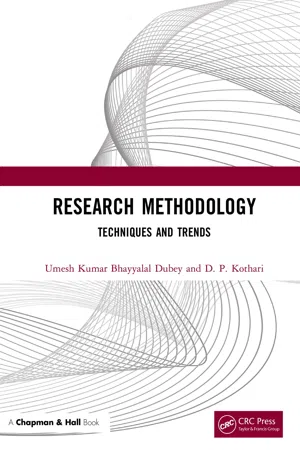Marketing
Sampling Plan
A sampling plan in marketing refers to the method used to select a representative group of individuals or elements from a larger population for research or analysis. It outlines the criteria for selecting the sample, such as demographics or geographic location, and the sampling technique to be used, such as random sampling or stratified sampling. The goal is to ensure that the sample accurately reflects the characteristics of the larger population.
Written by Perlego with AI-assistance
Related key terms
7 Key excerpts on "Sampling Plan"
- eBook - ePub
Marketing
A Relationship Perspective
- Svend Hollensen, Marc Oliver Opresnik(Authors)
- 2019(Publication Date)
- WSPC (US)(Publisher)
The main drawbacks of personal interviewing are the high costs and sampling problems. Group interview studies usually employ small sample sizes to keep time and costs down, but it may be hard to generalise from the results. Because interviewers have more freedom in personal interviews the problem of interviewer bias is greater.Thus there is no ‘best’ contact method – it all depends on the situation. Sometimes it may even be appropriate to combine the methods.Sampling Plan
A Sampling Plan is a scheme outlining the group (or groups) to be surveyed in a marketing research study, how many individuals are to be chosen for the survey, and on what basis this choice is made.Sampling unit:Except in very restricted markets it is both impractical and too expensive for a researcher to contact all the people who could have some relevance to the research problem. This total number is known statistically as the ‘universe’ or ‘population’. In marketing terms, it comprises the total number of actual and potential users/customers of a particular product or service.The population can also be defined in terms of elements and sampling units. Suppose that a lipstick manufacturer has aSampling Planto assess consumer response to a new line of lipsticks and wants to sample females over 15 years of age. It may be possible to sample females of this age directly, in which case a sampling unit would be the same as an element. Alternatively, households might be sampled and all females over 15 in each selected household interviewed. Here the sampling unit is the household, and the element is a female over 15 years old.What is usually done in practice is to contact a selected group of consumers/customers to be representative of the entire population. The total number of consumers who could be interviewed is known as the ‘sample frame’, while the number of people who are actually interviewed is known as the ‘sample’. - eBook - ePub
Dissertation Research Methods
A Step-by-Step Guide to Writing Up Your Research in the Social Sciences
- Philip Adu, D. Anthony Miles(Authors)
- 2023(Publication Date)
- Routledge(Publisher)
Figure 16.1 illustrates the major steps in the sampling process.Source: Adopted from Sekaran and Bougie (2013).Figure 16.1The sampling process.Before choosing a specific type of sampling technique, a broad sampling technique needs to be decided on. One of the difficult aspects of research is launching an experience-sampling study. It can provide a challenge to even the most seasoned researcher (Christensen et al., 2003 ). When a researcher decides to begin the research process, they must go through the sampling process first. The first stage in the sampling process is to clearly define the problem. Defining the problem is the basis for all research. This also relates to determining the sampling frame. The sampling frame must be representative of the population of interest. This is vital to the research.The next step is to determine the sample design. Establishing the sample design is very important to the researcher. The next step is to determine the appropriate sample size for the study. We have to remember that the population is commonly related to the number of people living in a particular area of the country. Lastly, the researcher has to execute the sampling process. Again, sampling can be used to make inferences about a population.Types of Sampling
The practice of sampling can be used to make an inference about a population or to make a generalization in relation to an existing theory. This is based on the choice of sampling technique.The practice of evaluating the characteristics of an entire population through a representative sample can be an arduous endeavor. As with many research studies, the best strategy to investigate a problem in an entire population is through the use of sampling. How, it is not always possible to conduct a study on an entire population. So, we use the practice of sampling. Thus, the researcher studies a sample of the population, which is a suitable representation of the entire population. We must think of a sample as a subset of the population; thus it is selected to be representative of the population. Again, one of the advantages of sampling is that it can be less costly and more efficient. Being able to use a sample to generalize the results to a whole population requires the use of one of the statistical sampling methods for evaluation. Taking a subset from a chosen sampling frame or entire population is the basic practice of sampling. - eBook - ePub
Research Methodology
Techniques and Trends
- Umesh Kumar B Dubey, D P Kothari(Authors)
- 2022(Publication Date)
- Chapman and Hall/CRC(Publisher)
6 Sampling DesignDOI: 10.1201/9781315167138-66.1 Introduction to Sampling
Where it is not possible to study the entire population, in such situations researchers use the concept of sampling. For a variety of reasons, researchers usually cannot make direct observations of every unit of the population they are studying. Instead, they collect data from a subset of population called as a sample and use these observations drawn to make inferences about the entire population.Ideally, the characteristics of a sample should correspond to the characteristics of a population from which the sample was drawn. In that case, the conclusions drawn from a sample are probably applicable to the entire population.Sampling is the backbone of marketing research. In this chapter, you will be introduced to various sampling concepts. A brief mention of sampling and nonsampling errors will be made. The various probability and nonprobability sampling designs as applicable to marketing research will be introduced. Since the choice of sample size involves various elements such as time, money accuracy, etc., an important decision while taking a sample is to know how large a sample should be taken. Therefore, the determination of sample size would also be discussed.6.2 Basic Definitions and Concepts
Researchers usually cannot make direct observation of every individual in the population under study. Instead, they collect data from a subset of individuals called as a sample and to make inferences about the entire population using those observations.6.2.1 Element
The unit about which information is collected is called as an element. According to a well-defined procedure this provides the basis for analysis. Elements should be well defined and the possibility of identifying them physically is important. For example, in a retail stores survey, a shop may be considered as a unit, whereas in a family budget enquiry a household may be treated as a unit. - eBook - ePub
- John K. Taylor(Author)
- 2018(Publication Date)
- Routledge(Publisher)
A sample taken according to a systematic plan, with the objective of investigating systematic variability of the universe of concern. Systematic effects due to time or temperature are typical matters of concern.Random Sample: A sample selected by a random process to eliminate questions of bias in selection and/or to provide a basis for statistical interpretation of measurement data. Composite Sample: A sample composed of two or more increments that are combined to reduce the number of individual samples needed to average compositional variability.There are basically three kinds of Sampling Plans that can be used in a measurement process [142A]. Intuitive Sampling Plans may be defined as those based on the judgment of the sampler. General knowledge of similar materials, past experience, and present information about the universe of concern, ranging from knowledge to guesses, are used in devising such Sampling Plans. Because the samples are based on judgment, only judgmental conclusions can be drawn when considering the data. In the case of controversy, decisions on acceptance of conflicting conclusions may be based on the perceived relative expertise of the those responsible for sampling.Statistical Sampling Plans are those based on statistical sampling of the universe of concern and ordinarily can provide the basis for probabilistic conclusions. Hypothesis testing can be involved, predictions can be made, and inferences can be drawn. Ordinarily, a relatively large number of samples will need to be measured if the significance of small apparent differences is of concern. The conclusions drawn from such samples would appear to be non-controversial, but the validity of the statistical model used could be a matter of controversy.Protocol Sampling Plans may be defined as those specified for decision purposes in a given situation. Regulations often specify the type, size, frequency, sampling period, and even location and time of sampling related to regulatory decisions. Not specifically following any part of the protocol could be reason for discrediting a sample. The protocol may be based on statistical or intuitive considerations but is indisputable once established. Testing for conformance with specifications in commercial transactions is another example. Agreement and definition of what constitutes a valid sample and the method of test are essential in many such cases. - Richard Harris, Claire Jarvis(Authors)
- 2014(Publication Date)
- Routledge(Publisher)
The characteristics of a sample are known as its statistics. The stages of the sampling process are outlined within Figure 4.1. This chapter begins by looking in more depth at the general steps that need to be taken before constructing a Sampling Plan. A considered and focused research question is a key start to this process (Section 4.3), as is a review of the related literature to find out what factors might influence the variable you are sampling. Together, these points feed into a review of the scope of your study to make sure that the work looks manageable with the time and resources you have available. With these tasks in hand, the next step in the sampling process is to define your target population, an operation known as constructing your sampling frame. Once these issues have been considered, the first stage of the sampling process, involving the scope and scale of the project, is complete. In the second half of the chapter, we turn to the sampling method itself. There are many well-documented general sample design strategies, where sample design is the method by which you select a subset or sample of data for a particular purpose. Figure 4.1 The process of sampling Considering which design best meets the goals of your study forms an important next step in the process, with the underlying aim behind the process of sample design being to ensure that the subset of data collected reflects the characteristics of the overall target population. Sub-questions here include how the design should be parameterised, and whether you should first conduct a pilot study. Theoretical ideals and practical realities conflict; the chapter therefore also includes some practical pointers that may suggest that your sampling strategy needs modification before you go out in the field. The chapter is of clear relevance to those who are going to undertake primary data collection and analysis- eBook - ePub
- Sunny Crouch, Matthew Housden(Authors)
- 2012(Publication Date)
- Routledge(Publisher)
A sample is a limited number taken from a large group for testing and analysis, on the assumption that the sample can be taken as representative of the whole group. Most people are familiar with the concept of sampling and its application in many everyday areas of life. For example, we take a sip of a drink or a bite of food to determine whether or not we are going to enjoy it. We are also familiar with the idea that scientists wishing to check the quality of a production batch will take a small sample from a large batch of product, and subject the sample to analysis to determine the constituents and their proportions in the whole batch. It is exactly this procedure which the marketing researcher is seeking to apply when sampling is used in survey research. From the example given it is easy to see that the major constituents of the production batch will only be represented in the correct proportions if the sample selected by the scientist for test was from a well-mixed batch, i.e. is representative of the whole content of the batch. The techniques of sample selection seek to ensure that the members of a survey sample are truly representative of all the members of the population from which they are derived. This therefore underlines the importance of correct sampling procedures in research. Without them the sample selected will not be representative and the answers gathered from them will not be a good guide to what the population of interest would say if all of them were asked.7.3 Why use a sample?
In survey research, samples are used to make an estimate of what the whole population of interest is like or what it thinks or does. In theory, it would be possible to measure or to question all members of the population of interest; this is known as a census, but in practice this would prove difficult. It is the practical advantages that account for the fact that samples are the normal method of collecting data, rather than censuses in which everyone must be included. The smaller the number of people from whom data is to be collected, the cheaper and quicker the process will be. Analysis of the data will be more manageable and control of the whole procedure more effectively achieved. Added to these highly practical advantages is the fact that good sampling procedures allow a high degree of precision in estimating the results that would have been achieved from a census, and so the argument for sampling becomes overwhelming and explains its almost universal usage. - eBook - ePub
Marketing Research
Planning, Process, Practice
- Riccardo Benzo, Marwa G. Mohsen, Chahid Fourali(Authors)
- 2017(Publication Date)
- SAGE Publications Ltd(Publisher)
It might seem reasonable to assume that this selection process is fairly straightforward, if a piece of research is focusing on a problem, issue or phenomenon with clearly defined boundaries. This is not always the case and is the reason why this chapter focuses on the many facets of sampling, as the technique that makes it possible for researchers to choose an appropriate group of people (sample) from a target population; ultimately, the aim is to uncover the truth about how they think, feel and behave.Sampling should be regarded as an integral component of a research design (see Chapter 5 , ‘Marketing Research Designs’). In other words, students and professionals should reflect on sampling as they develop the overall structure of a project, starting from the moment they begin to consider who would best be suited to provide relevant information. Once a specific path for primary research data collection emerges, a sample should be selected using one of the techniques illustrated in this chapter.Snapshot: Respondents, Participants and SubjectsHowever we term people who agree to take part in marketing research, there is little doubt that they are a fundamental component of a project, possibly determining the eventual reliability of findings and outcomes alike. The way in which we single them out is highly likely to influence the resulting data, information and knowledge. Sampling is in fact an area often neglected by researchers, academic or professional, and it does not normally register on the student radar until it is perhaps late in an assignment, or even too late.One of the world-defining studies on national culture is a typical example of the importance of striking a balance between who is being observed and the conclusions being drawn from the observation. In this specific instance, a large database was used as a platform to make comparisons ‘across individuals, across occupations, across countries, between the sexes, among age groups, and over time (1968 to 1972)’ (Hofstede, 1983a: 49). Due to its global presence, IBM (International Business Machines Corporation) was thought to be ideally placed to provide the necessary pool of data. Of the original 67 countries included in the study, only 40 made the cut, although a further 10 were added later on together with three regions.
Index pages curate the most relevant extracts from our library of academic textbooks. They’ve been created using an in-house natural language model (NLM), each adding context and meaning to key research topics.






